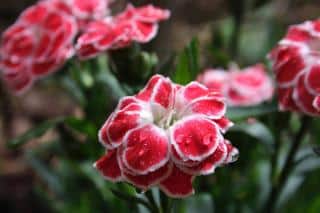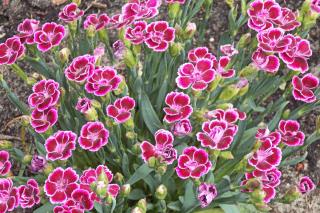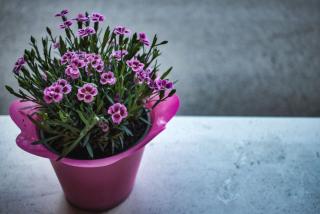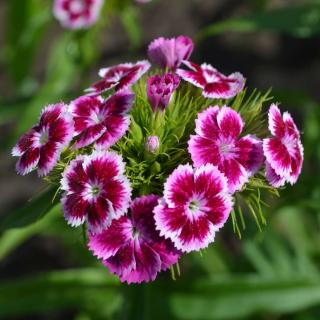

Carnation, whether annual or perennial, shares simple and beautiful blooms.
Key Carnation facts
Name – Dianthus
Family – Caryophyllaceae
Type – perennial, annual or biennial
Height – 8 to 32 inches (20 to 80 cm)
Exposure – full sun, part sun
Soil: ordinary – Flowering: end of spring to early fall
Caring for carnation is easy so here are the tips to produce magnificent flowers all summer long.

 No importance, plant in fall or in spring, carefully keeping a space of 8/10 inches (20/25 cm) between plants.
No importance, plant in fall or in spring, carefully keeping a space of 8/10 inches (20/25 cm) between plants.
The most important is to make sure the soil never dries out. This might mean watering every day. Evening is best, but in hot weather you can give a little water around noon. Make sure it isn’t cold from the tap, let it sit an hour or so before pouring it under the leaves.
Carnation is very resilient and only requires little care.
 To stimulate appearance of new flowers, cut wilted flowers regularly (deadheading).
To stimulate appearance of new flowers, cut wilted flowers regularly (deadheading).For perennial carnations, cut the stems to an inch (a couple centimeters) in fall and if possible cover with dead leaf mulch.
For annual carnations, pull them out in fall because they don’t grow back year after year.
Actually, carnation is a common name that refers to a great many grassy flowers, most of them part of the Dianthus family.
The scope and range of the carnation species means there is always one to meet any combination of shape and color.
This perennial or annual, depending on the carnation variety, is nonetheless always abundant in its blooming and thus helps populate your flower bed, edges, rocky ground or garden boxes.
Not to be confused with French marigolds which is part of the Asteraceae family, and which often is lumped together with carnations due to their resemblance, carnation is a distinct set of species and cultivars.
With bright colors and very fragrant, seize the opportunity of mixing several species within the same flower bed.
These carnations hold very well in a bouquet and are beautiful in a floral composition.
My perennial canation is very woody and strong so I want to thin it out and put in other parts of the garden it is always a white flower with lots of scent Irene.
Hi Irene, that’s for sure something you can try out. Carnation will grow very well from cuttings. You should take the cuttings from new growth, when the stem is still flexible. Old, woody stems might work but it won’t be nearly as successful. But if you’re trimming the plant back anyway, you can for sure try sticking lots of stem pieces into the soil, some of them might root even though it’s old wood.
You’re lucky with the scent, not all carnation are fragrant enough to notice!
Are there carnation stem support products available such as a miniature cage similar to tomato cages? My new carnations are about 12 inches tall and rest on the ground.
I have a carnation plant where the stems have become very woody and aren’t producing much foliage any more. What can I do to improve its growth?
Hi Patti! I think you’ll be ok simply cutting them back to about 2-3 inches (5-8 cm) long. There are a few carnation varieties that wouldn’t take this very well, but they aren’t very common.
Once you’ve cut the stems, make sure of this: keep the soil moist, but not soggy! Having too much water in the roots, without any leaves to “pump it out”, could invite root rot or other diseases in the root.
Note that you can also make cuttings from the stems you prune out. A good way to prepare for the worst, in case the variety doesn’t like pruning back to woody stems!